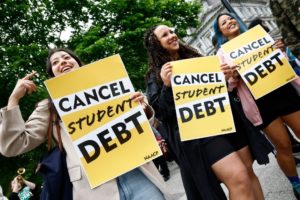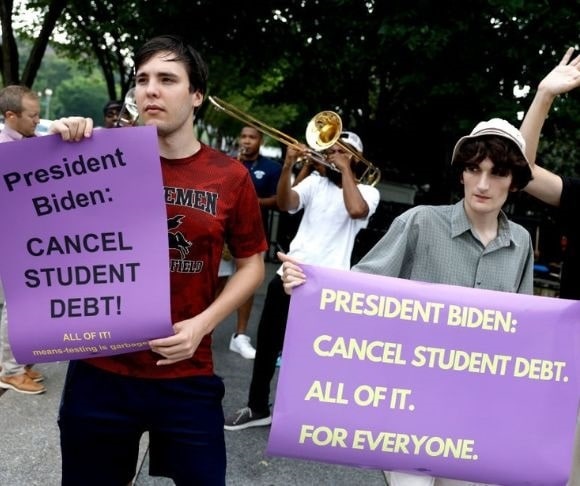As perhaps a way to end the month of August on a high note à la George Costanza from Seinfeld, President Joe Biden unveiled his student loan forgiveness plan. For progressives, the $10,000 to $20,000 amount was too little. For conservatives, the figure was too much. Whatever the political strategy on either side of the aisle, any proposal that takes debt incurred by completing a college Gender Studies course and reallocates it to plumbers and career waitresses is bad economics.
Student Loan Forgiveness Incentivizes Greed
The higher-education system is in shambles. Over the years, there has been a greater focus on hiring administrative professionals with a specialty in diversity and inclusion than preparing soon-to-be graduates for the real world. Universities are giddy anytime students arrive on campus with $50,000 in government-backed loans that can be consumed to build opulent facilities for staff and students instead of fostering an environment of learning, independence, and preparation. It is not surprising that the average annual cost of tuition and fees has exceeded the rate of inflation over the last 20 years, more than doubling to nearly $15,000. This model incentivizes greed in post-secondary institutions.
State-funded student loans have facilitated the meteoric rise in what young people pay to study. The more the Leviathan guarantees, the more schools can raise tuition. Rather than trimming the fat, cutting back, and doing more with less, they can build cathedrals, hire hundreds of administrators, pay exorbitant salaries to famous people who teach one class a month, and maintain the status quo. Student loan forgiveness exacerbates this issue and fails to tackle the root cause of why so many Americans are drowning in red ink. Instead, it is a short-term remedy that allows long-term issues to fester.
Put simply, universities will raise tuition. It is comparable to automakers increasing the price of their electric vehicles by $7,500 because the federal government is handing out $7,500 EV tax credits. As a result, blue-collar and middle-class workers will be forced to subsidize multi-billion-dollar behemoths.
Subsidizing Bad Decisions

(Photo by Anna Moneymaker/Getty Images)
By having the government offer student loans without any market-oriented forces, young people were enabled to enroll in programs they enjoyed and not something that could reward them with good careers and steady paychecks. Be it Lesbian Dance Theory or Orange Man Bad Studies, enrollees took anything since it had been ingrained into them from middle school that a university degree was the golden ticket to wealth and success. This has hardly been the case for many graduates, particularly those who received pieces of paper related to lackluster fields. But now that taxpayers have forgiven a portion of their student loans, many will repeat the same mistakes, head back to school, and study another irrelevant subject or build upon the bachelor’s degree.
In addition, why would families work hard to pay for Little Suzie and Tiny Tim’s tuition? If they expect the government to swoop in and forgive a large portion, then there is little incentive to be responsible.
Deficits and Inflation
Contrary to what some on the left might believe, there is a cost to canceling student debt. The Penn Wharton model estimates that eradicating $10,000 in debt for borrowers currently earning up to $125,000 would cost taxpayers up to $330 billion over the next decade. So much for the president’s deficit-busting campaign in the Inflation Reduction Act.
Moreover, this policy will likely add to inflationary pressures because it will lead to greater consumer demand in the broader economy, which has been one of the sources of today’s cost-of-living crisis. This was even noted by former Treasury Secretary Larry Summers in an Aug. 22 tweet:
“I hope the Administration does not contribute to inflation macro economically by offering unreasonably generous student loan relief or micro economically by encouraging college tuition increases. Every dollar spent on student loan relief is a dollar that could have gone to support those who don’t get the opportunity to go to college.
“Student loan debt relief is spending that raises demand and increases inflation. It consumes resources that could be better used helping those who did not, for whatever reason, have the chance to attend college. It will also tend to be inflationary by raising tuitions.”
He also warned that Biden’s concept “should not set any precedent.” However, since the government never learns from its mistakes, it is almost inevitable that the state will revive this policy in the next couple of years to generate more votes. It will start with $10,000 and then quickly climb to $20,000 or $50,000. For now, the average taxpayer is estimated to be on the hook for $2,000.
Whataboutism: PPP Edition
Leftists are pointing out that conservatives dismissing the president’s student loan forgiveness initiatives are hypocrites if their Paycheck Protection Program (PPP) loans were forgiven. But this argument falls flat on its face for a couple of reasons. These loans were given out to businesses during the COVID pandemic. The government forcefully shut down the economy and harmed companies, employees, and operations, so the loan forgiveness was redress. The PPP was terribly designed and rolled out and should have never existed. In the end, nobody pushed any Millennial or Generation Zer to sign up for a $50,000 degree to study anthropology.
Negative ROI
So, what would be the solution to the $1.76 trillion student loan debt crisis? There are several options available that could improve the system.

(Photo by Paul Morigi/Getty Images for We, The 45 Million)
The first is to remove the government from functioning as a predatory lender and allow a market-oriented approach to loans. A lender would offer loans to borrowers but use different criteria than the state. For example, somebody studying engineering or medicine would receive favorable terms and conditions, whether lower interest rates or a sublime repayment plan. However, a student looking to read about Medieval poetry would be extended an unfavorable loan structure, such as higher interest rates, penalties, and co-signers. The market would send signals that certain jobs are in greater demand than others.
If there is any “forgiveness” or “cancellation,” then the second idea would be to let the post-secondary system reimburse graduates. Because these entities failed their graduates and provided them with a negative return on investment (ROI), it should be up to organizations with a $41 billion endowment – not taxpayers – to refund the kids.
Ultimately, maintaining the status quo and throwing free money at the problem will not resolve this decades-old challenge. Tuition will continue to surpass inflation, 20-somethings will still leave school with exorbitant levels of debt, many degrees will remain worthless, and the cycle will repeat itself with graduates demanding more relief. Bailouts beget bailouts, and it all metastasizes into moral hazards, from the big banks to the military-industrial complex to prestigious universities. Nothing changes.




